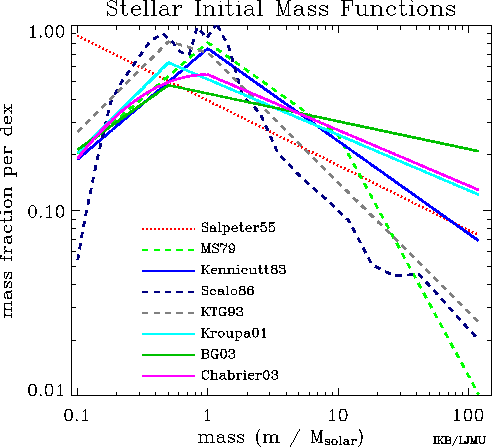
The stellar initial mass function (IMF) is used for computing stellar masses and colors of galaxies in cosmology.
List of some IMFs used in cosmology: Salpeter '55 eq. 5; Miller & Scalo '79 table 7; Kennicutt '83 section V; Scalo '86 table; Kroupa, Tout & Gilmore '93 eq. 13; Kroupa '01 eq. 2; Baldry & Glazebrook '03 abstract; Chabrier '03 table 1.
 |
This figure compares the IMFs by ploting mass fraction per dex versus mass, i.e., normalized so that the integral under each curve is unity. They are assumed to be valid from 0.1 to 120 solar masses. |
List of population synthesis codes: BaSTI; GALAXEV (BC03); Maraston '05; PEGASE; Starburst99.
For consistency, stellar mass should include normal stars (main sequence + giant branch) and evolved degenerate stars (white dwarfs + neutron stars + stellar-mass black holes) as this is the material that is not in the ISM or IGM. For example, there are three lines to combine in PEGASE. Depending on the IMF and population age, evolved stars can add 30% to the mass due to normal stars. Another definition of stellar mass that is sometimes used is the integral of the SFR; this can be twice the stellar mass defined above.
Ivan Baldry, written 2006 August 14th; updated 2008 April 20.